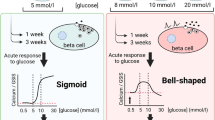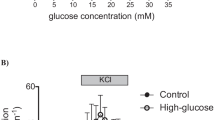Abstract.
Insulin secretion from isolated pancreatic islets of 8- to 12-day-old rats was investigated in a dynamic in vitro (perifusion) system. The aims of the study were (i) to describe a carefully controlled in vitro method to study the mechanism of insulin secretion and to analyse the effects and dynamic interactions of bioactive compounds on isolated rat pancreatic islets, (ii) to validate the method by comparing fundamental data on the functions of the islets obtained with this method to those collected with other techniques; and (iii) to find novel features of the control of insulin secretion. The method was carefully designed to maintain the functional capacity of the explanted cells. A functional standardization system was elaborated consisting of (i) analysis of the changes in the basal hormone secretion of the cells; (ii) evaluating responses to a standard, specific stimuli (50 mM glucose for 3 min); (iii) determining the alteration of the momentary size of the hormone pool with responses to KCl; and (iv) direct determination of the total intracellular hormone content from the extract of the column. The technique provides accurate quantitative data on the dynamic responses to biologically active compounds that act directly on the pancreatic islets. The islets maintained their full responsiveness for up to 7 days, and responses as close as in 1-min intervals could be distinguished. A linear dose-response relationship was found on the glucose-induced insulin release in case of 3-min stimulation with 4 and 500 mM of glucose (lin-log graph). Utilizing this method, we showed that no desensitization to glucose-induced insulin release can be observed if the responsiveness of the cells is properly maintained and the parameters of the stimulation are carefully designed. Exposure of the explanted islets to 10 μM acetylcholine or 30 mM arginine (Arg) induced a transitory elevation of insulin release similar in shape to that experienced after glucose stimulation. Norepinephrine (NE), dopamine (DA) and somatostatin (SS) did not induce any detectable alteration on the basal insulin secretion of the islets. However, 100 nM SS given together with 50 mM glucose, 30 mM Arg or 10 μM acetylcholine significantly reduced the insulin-releasing effect of these substances (by 75.5, 71.5 and 72.5%, respectively). At the same time, SS did not alter the insulin response of the islets to 100 mM elevation of K+ concentration. SS also inhibited glucose-induced insulin release in a dose-dependent way (ED50 = 22 nM). A similar dose-dependent inhibitory effect on glucose-induced insulin release was found with NE (ED50 = 89 nM) and DA (ED50 = 2.2 μM). γ-Aminobutyric acid (GABA) did not influence insulin release under similar circumstances.
Similar content being viewed by others
Author information
Authors and Affiliations
Additional information
Received 16 January 1998; received after revision 6 May 1998; accepted 8 May 1998
Rights and permissions
About this article
Cite this article
Csernus, V., Hammer, T., Peschke, D. et al. Dynamic insulin secretion from perifused rat pancreatic islets. CMLS, Cell. Mol. Life Sci. 54, 733–743 (1998). https://doi.org/10.1007/s000180050201
Issue Date:
DOI: https://doi.org/10.1007/s000180050201




